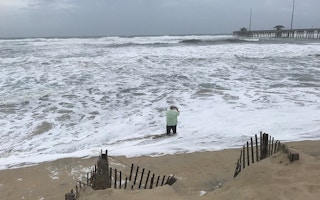Hurricane Florence, which smashed into the southeastern United States last week, is the latest in a string of extreme weather events that has raised expectations for disaster preparedness. With big storms occurring more frequently, authorities worldwide are responding with upgraded early-warning systems, better evacuation plans, and more aggressive sheltering strategies.
But the day is fast approaching when fires, droughts, and storms exacerbated by global warming will dwarf our ability to respond. The case for reducing carbon dioxide emissions—and slowing the rate of anthropogenic warming—grows stronger with every new catastrophe. The solution is clear: we must elect leaders who will take climate change seriously. In the US, the next opportunity to do that will be the midterm congressional elections in November.
Three decades have passed since former NASA scientist James Hansen first warned “with a high degree of confidence” that human activity was making the planet hotter. And yet, because too few people heeded his warnings then, everyone is paying a price now. In the first nine months of 2018, the world has experienced a lifetime’s worth of “historic” weather events—from drought-fueled forest fires in the American West, Greece, and Sweden, to floods in Hawaii, southern India, and elsewhere in South Asia. As Florence was tearing through the Carolinas, Typhoon Mangkhut was swamping the Philippines and southern China.
“
While domestic issues might be uppermost in voters’ minds, Harvey, Florence, and other extreme weather events have made global warming a local issue and placed it squarely on the ballot.
While Hansen’s warnings came when climate science was in its infancy, scientists today have connected the dots among CO2 emissions, climate change, and severe weather. For example, researchers have linked global warming to extreme heat waves—such as the ones recently experienced in California, China, Japan, and South Korea. Data have also tied the severity of hurricanes in the southern US to warmer waters in the Gulf of Mexico. Hurricane Harvey, which hit Texas and other areas in 2017, brought 50 inches of rain in some places.
To be sure, disaster planning still saves lives. In Houston, authorities were ready for Harvey in part because of lessons learned from Hurricane Katrina, which devastated New Orleans in 2005. That storm caused 1,833 deaths, while at least 88 were killed during Harvey.
The impact of lessons learned in India is even more striking. In October 2013, residents of Odisha state were alerted early to the arrival of Cyclone Phailin. By the time the storm made landfall, many people had already evacuated. Although Phailin did claim 45 lives, a storm of similar magnitude that hit the same region 14 years earlier killed 10,000 people.
Still, emergency management efforts will struggle to keep pace with the havoc wrought by climate change, owing to a dangerous disconnect between knowledge and action, even as the scientific evidence piles up. For example, many economic advisers still consider climate-change solutions to be anti-growth rather than pro-growth—despite the fact that low-carbon solutions create new investment opportunities and jobs. Policymakers are equally reluctant to champion meaningful changes—like carbon taxes or the elimination of fossil-fuel subsidies. Leaders in most countries consider the status quo to be politically safer. Even weather reports on television typically fail to mention climate change as an underlying cause of severe meteorological events.
But the gap is most glaring at the policy level, particularly in the US. With the international response to climate change at a critical juncture, the Trump administration is putting the US economy on a path to higher CO2 emissions by reversing emissions limits for coal-fired power plants, encouraging higher fossil-fuel production, and rolling back support for wind and solar power.
None of this makes economic sense. To make matters worse, the White House’s proposed cuts to the National Weather Service and its loosening of environmental and zoning regulations will further impede disaster management.
As the world’s largest CO2 emitter per capita, the US has a unique responsibility to help solve the climate-change challenge. So do American voters. When they go to the polls in November, they must consider the candidates’ policies toward climate change. While domestic issues might be uppermost in voters’ minds, Harvey, Florence, and other extreme weather events have made global warming a local issue and placed it squarely on the ballot.
Vinod Thomas, former Director General of Independent Evaluation at the World Bank, is a visiting professor at the National University of Singapore.
Copyright: Project Syndicate, 2018.
www.project-syndicate.org











